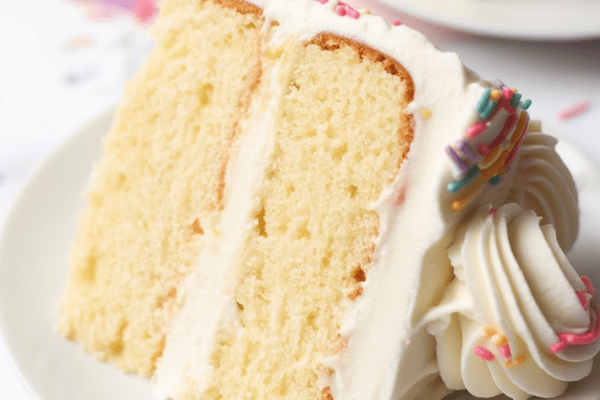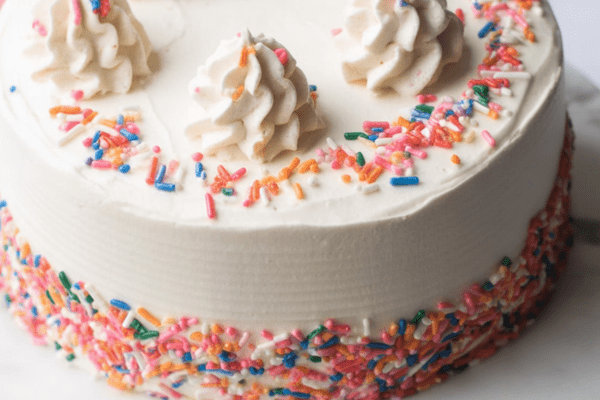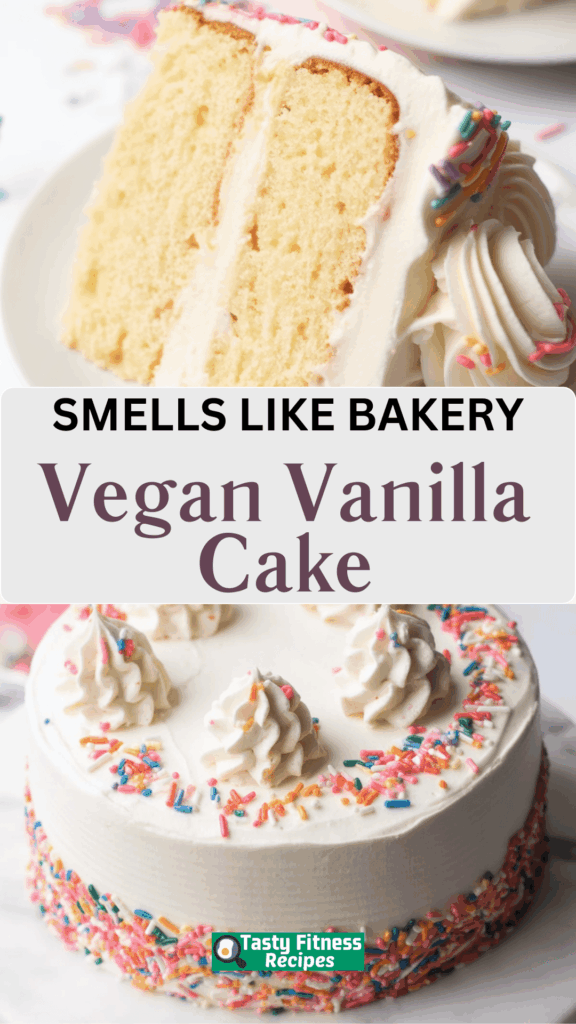With a moist and fluffy crumb and decadent vanilla flavor, this Vegan Vanilla Cake is one of those bakes I find myself making for just about everything—from birthdays to quiet Sunday afternoons when the house smells like a bakery and everyone is hovering in the kitchen waiting for a slice.

Vegan Vanilla Cake Recipe You’ll Ever Need
This cake is my trusty go-to whenever someone says “You’re vegan? But can you make real cake?” It’s my answer to all the skeptics. Moist, fluffy, and layered with sweet vanilla frosting, it always earns those wide-eyed “Wait, this is vegan?” responses.
Honestly, I make it for my own birthday every year. It’s easy to customize too—I’ll sometimes add a layer of homemade jam between the cakes or pile it high with fresh berries if I’m feeling fancy. You can really make it your own.
Why This is the Best Vegan Vanilla Cake
This is the cake I dreamed of when I first went plant-based. I wanted that classic, bakery-style crumb with rich vanilla notes, but without the eggs and dairy. After a lot of trial and error (and some truly sad, dense cakes), this one nailed it.
Two secret ingredients: Aquafaba and cake flour. Don’t be intimidated by aquafaba—it’s literally just the liquid from a can of chickpeas. I keep a couple of cans in my pantry at all times. I love that this humble pantry staple makes the cake so light and airy.
And cake flour? It’s worth buying if you don’t have it. I swear, every time I use it, I think “This is why bakery cakes taste so good.” But even with all-purpose flour, it’s still really lovely.
Perfect for any occasion? Absolutely. I’ve taken this cake to potlucks, bridal showers, and kids’ parties. I even made it once for a wedding dessert table (just doubled the recipe). It holds up beautifully and can be dressed up or down depending on what you’re celebrating.

How to Make Vegan Vanilla Cake
Here’s how I make it, with some of my own tips from baking it dozens of times:
1. Prep your pans well. Don’t skip the parchment rounds on the bottom. They make lifting the cakes out so much easier. Nothing kills my mood faster than half the cake sticking to the pan.
2. Homemade vegan buttermilk. This is just non-dairy milk plus apple cider vinegar. I usually use soy milk for its higher protein content, but almond or oat milk work too.
3. Aquafaba. I whisk it until it’s nice and foamy, which only takes a couple of minutes by hand. No fancy equipment needed. If I’m feeling lazy, I swap in vegan yogurt. Both give you that fluffy lift.
4. Mixing the batter. Go slow when alternating the dry and wet ingredients. Overmixing will toughen it up. I usually stop as soon as I can’t see dry flour. A few lumps are fine.
5. Baking. I start checking at 28–30 minutes. Every oven is different. Mine tends to run hot, so I keep a close eye.
6. Cooling. Let them cool fully before frosting. If I’m in a rush, I pop them in the fridge once they’re just warm. This helps avoid melting your beautiful frosting.
Frosting and Decorating
I’m partial to classic vegan buttercream with sprinkles on top—it feels festive without much effort. But sometimes I go with vegan cream cheese frosting for a little tang or pile it with fresh strawberries and vegan whipped cream in the summer.
Once, for my niece’s birthday, we made rainbow layers and she decorated the whole thing with edible flowers and more sprinkles than I thought possible. It was chaos, but she was thrilled.

Frequently Asked Questions
I Don’t Have Cake Flour. What Can I Use Instead?
I get it—sometimes you just want cake now. All-purpose flour works perfectly well; your cake will be slightly denser but still delicious. When I’m out of cake flour, I just mix all-purpose with a bit of cornstarch (1 cup minus 2 tablespoons flour + 2 tablespoons cornstarch). It’s an easy hack I’ve used many times.
Can It Be Made Gluten Free?
Yes! I’ve made this with a 1:1 gluten-free flour blend when baking for friends with allergies. It turns out a bit different—slightly less fluffy—but everyone still devoured it. Just make sure you use a high-quality blend that includes xanthan gum or a binder.
What Is Aquafaba?
It sounds fancy but it’s just chickpea water. I always save it from cans of chickpeas. You can freeze it too if you don’t plan on baking immediately. It whips up like egg whites, giving you all that airy lightness without any animal products.
When I first tried it in baking, I was so skeptical, but it really works wonders. Now I can’t imagine vegan baking without it.
What Can I Use Instead of Aquafaba?
If you’re out of chickpeas or don’t want to deal with aquafaba, vegan yogurt works beautifully. I like using unsweetened, unflavored soy yogurt for best results. It keeps the cake moist and tender. I’ve also used flax eggs in a pinch, but the texture isn’t quite as fluffy.
Can I Make It in a Different Pan?
Yes! I’ve baked it in a 9×13-inch pan for easy sheet cakes, in cupcake tins for parties, and even as a single-layer 10-inch cake. Just adjust the baking time. For cupcakes, I check them at around 20 minutes. For larger pans, add 10–15 minutes and keep testing with a toothpick.
Vegan Vanilla Cake

With a moist and fluffy crumb and decadent vanilla flavor, this Vegan Vanilla Cake is one of those bakes I find myself making for just about everything.
Ingredients
Dry Ingredients
- 3 cups cake flour
- 1 tablespoon baking powder
- 1/2 teaspoon salt
Vegan Buttermilk
- 1 1/4 cups unsweetened soy milk
- 2 teaspoons apple cider vinegar
- Aquafaba (or substitute 1/2 cup vegan yogurt)
- 1/2 cup aquafaba
- 1/4 teaspoon cream of tartar
Remaining Ingredients
- 1/2 cup vegan butter, softened to room temperature
- 1/2 cup canola oil
- 1 1/2 cups sugar
- 1 tablespoon vanilla extract
Frosting and Toppings
- 1 recipe [vegan buttercream frosting]
- Vegan-friendly sprinkles (optional)
Instructions
- Preheat the oven to 350°F and position the rack in the center.
- Grease two 8-inch round cake pans with oil or vegan butter, and line the bottoms with parchment paper to make removing the cakes easier.
- In a medium bowl, whisk together the flour, baking powder, and salt, then set it aside.
- Combine the soy milk and apple cider vinegar in a measuring cup or small bowl, give it a quick stir, and let it sit to curdle.
- In another small bowl, whisk the aquafaba and cream of tartar vigorously for about 2 minutes until it becomes foamy and light. It doesn't need stiff peaks—just some fluffy volume. Set it aside.
- Using a large bowl and an electric mixer (or a stand mixer with a paddle attachment), beat the softened vegan butter, canola oil, and sugar for about 3 minutes until the mixture is creamy and smooth, scraping down the sides as needed.
- Add the aquafaba mixture and vanilla extract to the creamed butter mixture and mix for about a minute until everything is well combined.
- Gradually add the dry flour mixture and the vegan buttermilk in alternating additions, doing this in three parts. Mix just until combined each time, being careful not to overmix. A few small lumps are fine.
- Pour the batter evenly into the prepared pans.
- Bake for 30 to 35 minutes, or until the edges are golden, the tops are set, and a toothpick inserted into the center comes out mostly clean.
- Allow the cakes to cool in the pans for 15 minutes before carefully inverting them onto a wire rack to cool completely.
- Once fully cooled, frost with your favorite vegan frosting and add sprinkles for a festive touch if you'd like. Enjoy!
Notes
- Cake flour creates a lighter texture, but you can easily use all-purpose flour instead or even make your own version of cake flour at home.
- For a gluten-free option, choose a high-quality gluten-free all-purpose flour blend to get the best results.
- Soy milk is the top choice because of its protein and fat content, but you can also use other plant-based milks such as hemp, oat, cashew, or almond milk.
- If you have it on hand, unsweetened high-fat or high-protein vegan yogurt makes an excellent replacement for aquafaba.
- When making cupcakes, fill the liners halfway and bake for about 20 to 25 minutes.
- For a 9×13 inch cake, bake for 40 to 50 minutes. Using two 9-inch round pans will give you slightly thinner layers.
Recommended Products
As an Amazon Associate and member of other affiliate programs, I earn from qualifying purchases.
Nutrition Information
Yield
16Serving Size
1Amount Per Serving Calories 293Total Fat 13gSaturated Fat 2gTrans Fat 1gUnsaturated Fat 11gCholesterol 1mgSodium 159mgCarbohydrates 41gFiber 1gSugar 20gProtein 2g
TastyFitnessRecipes.com, occasionally offers nutritional information for recipes contained on this site. This information is provided as a courtesy and is an estimate only. This information comes from online calculators. Although tastyfitnessrecipes.com attempts to provide accurate nutritional information, these figures are only estimates.
How Do You Store Vegan Vanilla Cake?
If I’m making it ahead for a party, I bake the layers the night before, wrap them tightly in plastic wrap, and store them in the fridge.
For leftovers (if there are any), I keep frosted cake in a cake carrier at room temperature for a couple of days. It dries out faster in the fridge, but if your frosting is really soft or it’s hot out, it’s safer in the fridge.
For longer storage, the unfrosted layers freeze beautifully for up to three months. I wrap them in plastic wrap and then foil. Just thaw overnight in the fridge before frosting.
Try other recipes:


